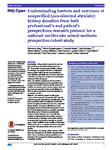Understanding barriers and outcomes of unspecified (non-directed altruistic) kidney donation from both professional’s and patient’s perspectives: research protocol for a national multicentre mixed-methods prospective cohort study
| dc.contributor.author | Gare, R | |
| dc.contributor.author | Gogalniceanu, P | |
| dc.contributor.author | Maple, H | |
| dc.contributor.author | Burnapp, L | |
| dc.contributor.author | Clarke, A | |
| dc.contributor.author | Williams, L | |
| dc.contributor.author | Norton, S | |
| dc.contributor.author | Chilcot, J | |
| dc.contributor.author | Gibbs, P | |
| dc.contributor.author | Mitchell, A | |
| dc.contributor.author | McCrone, P | |
| dc.contributor.author | Draper, H | |
| dc.contributor.author | Mamode, N | |
| dc.date.accessioned | 2020-10-19T15:39:34Z | |
| dc.date.available | 2020-10-19T15:39:34Z | |
| dc.date.issued | 2017-09 | |
| dc.identifier.issn | 2044-6055 | |
| dc.identifier.issn | 2044-6055 | |
| dc.identifier.other | ARTN e015971 | |
| dc.identifier.uri | http://hdl.handle.net/10026.1/16568 | |
| dc.description.abstract |
<jats:sec><jats:title>Introduction</jats:title><jats:p>Living donation accounts for over one-third of all kidney transplants taking place in the UK.<jats:sup>1</jats:sup>The concept of anonymously donating a kidney to a stranger (non-directed altruistic or unspecified kidney donation (UKD)) remains uncomfortable for some clinicians, principally due to concerns about the motivations and long-term physical and psychological outcomes in this donor group.</jats:p></jats:sec><jats:sec><jats:title>Aims</jats:title><jats:p>The research programme aims to provide a comprehensive assessment of the unspecified donor programme in the UK. It aims to identify reasons for variations in practice across centres, explore outcomes for donors and ascertain barriers and facilitators to UKD, as well as assess the economic implications of unspecified donation.</jats:p></jats:sec><jats:sec><jats:title>Methods</jats:title><jats:p>The research programme will adopt a mixed-methods approach to assessing UKD nationally using focus groups, interviews and questionnaires. Two study populations will be investigated. The first will include transplant professionals involved in unspecified kidney donation. The second will include a 5-year prospective cohort of individuals who present to any of the 23 UK transplant centres as a potential unspecified living kidney donor. Physical and psychological outcomes will be followed up to 1 year following donation or withdrawal from the donation process. A matched sample of specified donors (those donating to someone they know) will be recruited as a control group. Further qualitative work consisting of interviews will be performed on a purposive sample of unspecified donors from both groups (those who do and do not donate).</jats:p></jats:sec><jats:sec><jats:title>Dissemination</jats:title><jats:p>The findings will be reported to NHS Blood and Transplant and the British Transplant Society with a view to developing national guidelines and a protocol for the management of those presenting for unspecified donation.</jats:p></jats:sec><jats:sec><jats:title>Trial registration number</jats:title><jats:p>ISRCTN23895878, Pre-results.</jats:p></jats:sec> | |
| dc.format.extent | e015971-e015971 | |
| dc.format.medium | Electronic | |
| dc.language | en | |
| dc.language.iso | eng | |
| dc.publisher | BMJ | |
| dc.subject | altruistic/unspecified donation | |
| dc.subject | chronic renal failure | |
| dc.subject | kidney | |
| dc.subject | renal transplantation | |
| dc.subject | Altruism | |
| dc.subject | Attitude of Health Personnel | |
| dc.subject | Focus Groups | |
| dc.subject | Humans | |
| dc.subject | Kidney Transplantation | |
| dc.subject | Living Donors | |
| dc.subject | Motivation | |
| dc.subject | Prospective Studies | |
| dc.subject | Qualitative Research | |
| dc.subject | Quality of Life | |
| dc.subject | Research Design | |
| dc.subject | Surveys and Questionnaires | |
| dc.subject | Tissue and Organ Harvesting | |
| dc.subject | United Kingdom | |
| dc.title | Understanding barriers and outcomes of unspecified (non-directed altruistic) kidney donation from both professional’s and patient’s perspectives: research protocol for a national multicentre mixed-methods prospective cohort study | |
| dc.type | journal-article | |
| dc.type | Journal Article | |
| dc.type | Multicenter Study | |
| plymouth.author-url | https://www.webofscience.com/api/gateway?GWVersion=2&SrcApp=PARTNER_APP&SrcAuth=LinksAMR&KeyUT=WOS:000412650700089&DestLinkType=FullRecord&DestApp=ALL_WOS&UsrCustomerID=11bb513d99f797142bcfeffcc58ea008 | |
| plymouth.issue | 9 | |
| plymouth.volume | 7 | |
| plymouth.publication-status | Published | |
| plymouth.journal | BMJ Open | |
| dc.identifier.doi | 10.1136/bmjopen-2017-015971 | |
| plymouth.organisational-group | /Plymouth | |
| plymouth.organisational-group | /Plymouth/Faculty of Health | |
| plymouth.organisational-group | /Plymouth/Users by role | |
| dc.publisher.place | England | |
| dc.identifier.eissn | 2044-6055 | |
| dc.rights.embargoperiod | Not known | |
| rioxxterms.versionofrecord | 10.1136/bmjopen-2017-015971 | |
| rioxxterms.licenseref.uri | http://www.rioxx.net/licenses/all-rights-reserved | |
| rioxxterms.type | Journal Article/Review |


